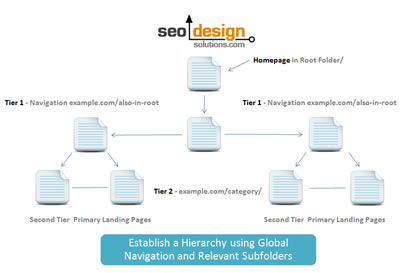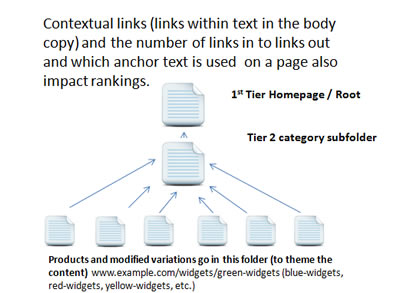Indexation is the first step in SEO and SERP (search engine result page) domination starts with building an optimal website template and using optimal website architecture.

SEO Tips for Templates Part 1
If your pages are not indexed, deindexed or are not getting indexed due to flaws in your websites site architecture, this this guide is a definitive source of information for future reference.
Search engine user agents (also known as search engine spiders) are looking for indicators to support the nodes of relevance required on a page by page and global level within the site.
If you pages fail to meet their algorithmic criteria, then your index cap lowers and pages tend to recede ( falling out of the index) due to duplicity or excessive noise from duplicity based on inconsistencies in links or your website template.
Keep in mind that this is part one of a series of posts but before we get into more detailed solution oriented applications, we need to create a preface outlining the pitfalls and symptoms commonly surrounding the problem which is lack of rankings or deindexation.
What are some of the more common errors associated with indexation?
- Poor site architecture
- Lack of internal links
- Lack of contextual links
- Orphaned pages
- Duplicate content
- Excessive number of outbound links per page
All of these are easily fixed, but you have to know what to look for and why to look for them in order to keep your sites performance optimal.
Be Mindful of SEO Metrics
- Search engines score unique content much higher than duplicated content as duplication invokes a null set or devaluation of the information simultaneous to elevating the original content as the original source of citation.
- Search engines use links (both from your own website and from other sites) to create correlations between hierarchical preference for each page.
- URI (Uniform Resource Identifiers) still carry weight, but they should be aligned in tandem with site architecture, internal links, contextual link preferences as well as off page inbound link considerations to add significant ranking factor to your pages.
- The further you nest pages in subfolders away from the root folder, the more link flow they require to feed the page, rank and become buoyant.
Common Mistakes that are Counter Productive to SEO:
Poor site architecture: Volumes alone could be written on this topic, but for the sake of relevance, we will briefly touch upon the basics.
Your website architecture should be determined by the competitiveness of the main keywords you are targeting and the thresholds established by the vertical online market the website is engaged in.
More competitive keywords require more content or a higher concentration of authoritative links from sites already ranking for those keywords. In other words links from relevant pages help more than links from off topic or irrelevant pages.
Similarly, this does not just apply to pages from outside the site. When you realize the implication of this statement, the fact that your own website can pass along ranking factor equally as well as links from other sites (known as deep links if they are linking to anything other than the homepage), this equates to theming your sites links based on categorical and monetary equivalents.
Creating Nodes of Relevance for Category Pages
For example, if your category pages have significance for multiple model numbers with an e-commerce site, then having that category page rank in addition to the individual make and model pages is equally important.

Example of 2nd Tier Category Pages
For example if the category is “coffee makers” and you feature 12 mfg’s and 3 models within each mfg. there needs to be a clear hierarchy of relevance within the site to determine which pages rank for which keywords. That is accomplished through site architecture and internal links.
If you have different brands like Cuisinart, Nesco, Faberware, etc. Then those landing pages would be nested and or linked from the main coffee makers category page. All links to the coffee makers category page should be linked with the keywords “coffee makers” and each respective sub-page or child page should also have contextual reference to other brand specific pages to reinforce their topical nodes of authority.
Those pages could also be supported by images with alt text linking to the preferred landing page with the keyword it is intended to rank for. Using server side includes (SSI) like a dynamic series or links or images with alt attributes is a great way to pull data dynamically based on tags or widgets which are independent of the global site template (to add distinct internal links and / or weight to product level pages).
Related Links or Server Side Includes
One tactful way is to use a suggest feature such as “people who liked this also liked (other brands / model)” to slip in those strong themed contextual links from “Relevant Page A to Relevant Page B”. By doing this dynamically or building it into the template itself, it accomplishes two things (1) a unique footprint of topical linking from relevant pages to other category, model or semantically aligned pages and (2) you don’t have to do this by hand, the taxonomy and sites virtual theme / tagging system (lateral tagging) implements intelligent linking by design.
If you are not using an intelligent or pliable CMS (content management system) then, you may have to resort to “old school” virtual theming methods to placate link equity for pages lacking sufficient internal links.
For example, say you are on the Nesco coffee makers main category page example.com/nesco-coffee-makers/ this page should be linked from example.com/coffee-makers/ with the keywords “Nesco coffee makers”.
Once on those sub pages, they should be linked to their parent “coffee makers” as well as you can use lateral linking to link across themes to other brand specific queries for “Cuisinart Coffee Makers”, models numbers, etc.
Capping the Number of Outbound Links Per Page
The rule of thumb is pages should not have more than 100 links leaving the page, if they do, then each one of those links is effectively sapping that page from retaining enough link flow and equity to effectively rank itself as well as the distinguished equity is can pass on to other pages is also diffused as a result of “theme bleeding”.
You have to make up for link loss the further you move away from the root example.com/coffee/coffee-makers/nesco/nesco-model-number.html whereby you could have easily created a page in the flat site architecture or the parallel to the category page such as example.com/coffee-makers/nesco-coffee-maker-model1234.html even though the main nesco category page may be one layer deeper in the architecture example.com/coffee-makers/nesco/.
The reason is, we hinted above that the further away you move from the root, the more emphasis and / or link flow you will need to push to the deeper subdirectories in order to improve the degree of link flow required to make that page buoyant.
Sure, if your site is a powerhouse, and has thousands of strong inbound links, this is not a concern, but developing that authority and getting the page to rank in the top 1000 results, then to breach the top 100 and top 10 search engine result pages respectively requires that you are able to manage each one of these steps systemically.
This is why it is important to use internal links in tandem with a structure for site architecture that reflects the barrier to entry for each of the given keyword variations.
Creating a Topical Precedence
If you (a) build a strong top down model and then feed each category page from the pages with the most relevance and link equity, one link from those pages to the child / model level pages is often more than enough to provide enough link equity to keep that pages indexed and ranking for some mid-tail or long-tail variation. Otherwise, you may have to build inbound links to those pages in volume in order to see their respective keywords rise to the top of the search engine result pages.
You could also opt to use off page ranking factor and acquire links from deep link directories, web 2.0 properties, blogs, article marketing, RSS feeds or editorial links to those individual deep pages to provide a suitable degree of peer review and increase the relevance score for those pages to produce a SERP position.
Personally, using both in tandem is ideal, however if you have to create correlation such as a percentage, I would suggest 70% internal links and theming and 30% off page inbound links from other sites to polish off a top 10 position.
This quality not quantity, and the higher the quality of your own internal link schema, the less off page ranking factor your individual pages require from sources outside your own website.
Avoiding Supplemental Results
You should consider that your website is only as strong as the weakest link, the more link equity and support you provide to the lowest pages in the food chain, the more link flow move upward in the site to the category pages, back to the home page then back into the rest of the site (laterally) to then seek pages to express that excess in “ranking credits” or buoyant ranking factor.
If you fail to map this stage properly, then you take the risk of your pages going into Google’s supplemental index (due to duplicity or lack of context to the main sites hierarchy).
This is the secret to search engine domination, using your own pages to support other pages (from the level of the template, the site ontology and taxonomies) in tandem with a structured content development strategy capable of capitalizing on the various nodes of keywords inherent in the vertical online markets keyword clusters.
This concludes part 1 of SEO Tips for Website Templates, stay tuned for the follow up post where we dig into the metrics of templates, internal links, and common areas duplicated across a website which can lead to deindexation (pages falling out of search engines or rankings tanking) or lack of relevance from search engines.











Nice SEO tips, being one SEO executive I am trying to improve my SEO work capabilities.
Hello
I always like this blog as I can learn more about SEO from this blog.These are nice and useful tips for website templates.Thank you very much for this helpful post.
I enjoyed the article and thanks for this information .
Thanks for sharing such nice SEO Tips Article
Hey,
Good article,
In addition can say that most of problems with indexing can be caused also by viruses etc.
I have never seen that as a problem, mostly in my experience by (1) poor site architecture (2) lack of links or (3) duplicate content from lack of content (and the template is too heavy) hence, search engines ignore it.
Thanks for commenting.
All the best!
Hi Jeffrey,
This will be my last comment/question for the night – I’m pretty much bug-eyed from all my reading.
I am trying to figure out what the best option is for a homepage for a 20-30 page website (4-5 category landing pages with 4-5 posts each).
Static? Latest posts? Sticky posts?
thanks
Kevin
5 landing pages off the root, then 5 categories with exact match for those landing pages (so you can drip articles supporting articles under them over time) which all link up to the primary landing page (in the root). Try to remove any unnecessary links in primary navigation to prevent theme bleeding and use sidebar secondary links to all articles in the category (and contextual links to primary landing page and / or other categories)…
Hope that helps.
Jeffrey
I feel like I’m so close to “getting it” but not quite…sorry.
By primary landing page I am assuming you mean the homepage?
When someone looks at my primary landing page (the content – not sidebars, navigation, etc) what should they see? The content of the 5 category landing pages or something else?
Also, I assume you recommend internal contextual links to the primary landing page similar to the category landing pages? Should these links come directly from all my posts, the category landing pages, or both?
I really appreciate your help.
Kevin
Love the way you go into details I can´t seem to find anywhere else. I have been trying to apply your advice on our soon-to-be-published site, I hope that in a few months I will be able to thank you again :-)
I feel a lot more confident though than a couple of months ago.Thx.
Thanks Ivo, appreciate you coming by.
Yes, we will update theme soon to compliment usability for skimming content quicker.